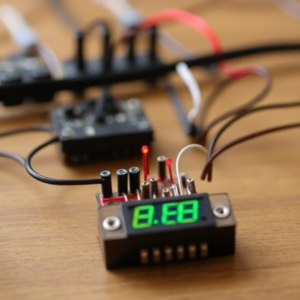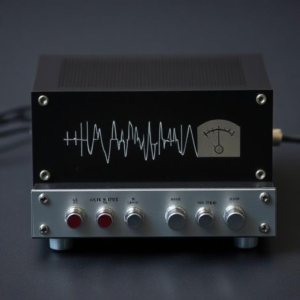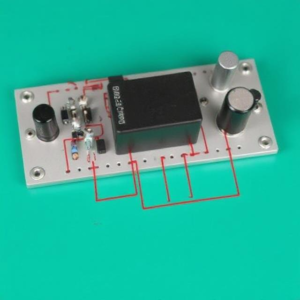What is a Comparator in Electronics?
A comparator is an electronic device that compares two voltages (or signals) and then outputs a signal based on which one is higher. It’s like a decision-maker for electrical signals. It doesn’t “amplify” signals like an op-amp; instead, it simply tells you which input is larger.
In simpler terms: A comparator checks if one voltage is greater than, less than, or equal to another voltage, and it gives a clear high or low output (often a digital signal).

How Does a Comparator Work?
Comparators have two input voltages:
- Inverting Input (V-)
- Non-inverting Input (V+)
The comparator works by comparing the voltages at these two inputs:
- If the voltage at the non-inverting input (V+) is greater than the voltage at the inverting input (V-), the output will be high (often the maximum voltage of the power supply, like +Vcc).
- If the voltage at the inverting input (V-) is greater than the voltage at the non-inverting input (V+), the output will be low (often 0V or ground).
So, a comparator is like a simple “greater-than” checker.
Key Features of a Comparator
- Two Inputs: One is the reference input (V-) and the other is the signal input (V+).
- Digital Output: The output is either high or low, depending on the comparison.
- No Feedback: Unlike amplifiers, comparators do not have feedback that adjusts their output gradually. The output jumps from low to high or high to low.
- Fast Response: Comparators respond quickly, making them useful for real-time digital decision-making.
Comparator Operation (with an Example)
Imagine we have:
- A reference voltage (V-) = 2V
- An input voltage (V+) that we change, say 1V, 3V, and so on.
- If V+ = 1V (less than 2V), the comparator output will be low (0V).
- If V+ = 3V (greater than 2V), the comparator output will be high (+Vcc, say 5V).
So, the comparator “compares” 1V and 3V to the 2V reference and then gives an output based on the comparison.
Comparator Output
The output of a comparator is usually a binary signal:
- High (1): If the non-inverting input (V+) is greater than the inverting input (V-).
- Low (0): If the inverting input (V-) is greater than the non-inverting input (V+).
This means the comparator is like a decision-making switch that turns on or off based on which input is higher.
Types of Comparators
- Open-Loop Comparator:
- It has no feedback mechanism, so it gives a sharp transition between high and low output states.
- It’s used when you need fast switching and a clear output.
- Window Comparator:
- A special kind of comparator where the output is high if the input voltage is within a specific window (range) between two reference voltages.
- It’s like saying: “Is the signal between these two limits?” If yes, the output is high; otherwise, it’s low.
Applications of Comparators
Comparators are used in many different applications, especially when decision-making is needed based on voltage levels. Here are some common uses:
- Zero Crossing Detector:
- A comparator can detect when a signal crosses zero voltage, which is useful in generating clock pulses for digital systems.
- Example: In a sine wave, the comparator can detect when the signal goes from positive to negative and vice versa.
- Pulse Width Modulation (PWM):
- Comparators are used in PWM circuits to compare a control signal (usually a triangle or sawtooth wave) with a reference, creating a digital signal that switches on and off at a certain frequency.
- Analog-to-Digital Conversion (ADC):
- Comparators can be used in ADCs to compare the input voltage with a reference voltage and create a digital output.
- Overvoltage or Undervoltage Detection:
- A comparator can be used to monitor a power supply and trigger an alarm or protection mechanism if the voltage goes above or below a certain threshold.
- Schmitt Trigger:
- A special type of comparator that includes hysteresis, which helps to eliminate noise from the input signal. It only changes its output when the input crosses a certain threshold by a specific amount, ensuring a clean digital signal.
- Window Comparators:
- In this case, the comparator is set to output high when the input is within a specific voltage range (the “window”). It’s useful for monitoring systems where you need to ensure the input stays within certain limits.
- Pulse Generation:
- Comparators are used to generate pulses, such as in timing circuits or frequency generators.
Advantages of Comparators
- Fast Response: Comparators quickly switch between high and low, making them suitable for real-time systems.
- Low Power Consumption: Most comparators use very little power when not switching.
- Simple Design: They are simple devices, often used in systems requiring basic voltage comparison.
- Versatile: Can be used in many applications from signal processing to digital logic systems.
Disadvantages of Comparators
- No Linear Output: Unlike operational amplifiers, comparators do not amplify the input signal; they just output a high or low value based on the comparison.
- Hysteresis (without Schmitt Trigger): Without hysteresis (as in a Schmitt Trigger), comparators can be sensitive to noise and may output unstable results if the input voltage is close to the threshold.
- Limited Output States: The output is limited to two states (high or low), unlike amplifiers that provide a continuous range of values.
Summary
A comparator is an electronic component that compares two input voltages and outputs a high or low signal based on which input is larger. It’s widely used in digital systems for decision-making processes such as voltage level detection, signal processing, and generating clock pulses. Comparators are fast, simple, and versatile but provide a binary output, meaning they can only tell whether one signal is greater than the other.
Keywords: Comparator, Electronics











